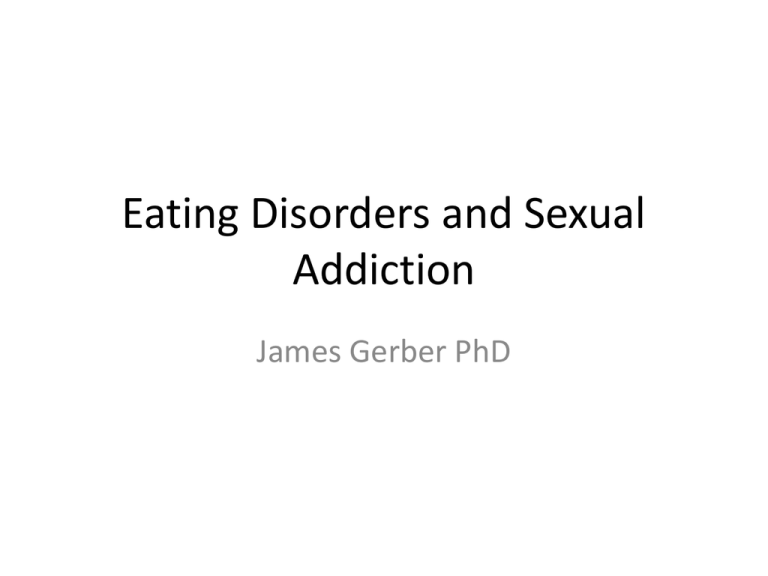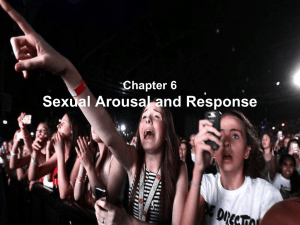
Eating Disorders and Sexual
Addiction
James Gerber PhD
•
•
•
•
•
•
•
Sex and Food
Both innate biologically driven motivation
Appetite/Desire/Hunger
Sensory pleasure
Gratification
Satiation
The same struggles of Anorexia and Bulimia, (over
control and under control) manifest in the person’s
sexual behavior and attitude. Therefore there are often
periods of binging (seeking partners to fill the void)
purging (release of orgasm) and restricting (aversion).
“In contrast to anorexics who restrict both
food and sexual activity, bulimic patients tend
to have more sexual involvements…Some
bulimic patients will do anything, risk
anything, even AIDs to avoid the inner
experience of abandonment. What appears to
be ploy for sexual fulfillment is really not
sexual at all” Zerbe, K. 1993
• Sexual Addiction and Compulsivity
• Pattern of out of control sexual behaviors
• A person risking or suffering consequences as a result of these
behaviors.
• An inability to stop despite the consequences.
• The use of sexual behaviors or fantasy as a primary way of
coping.
• A need to heighten the level of stimulation.
• An inordinate amount of time engaging in or seeking sexual
encounters.
• The neglect of other areas of life, such as career, academic,
recreational and social.
• Levels of Behaviors
• Excessive but socially acceptable i.e.
masturbation and pornography
• “Nuisance” behaviors such as prostitution,
voyeurism, phone calls.
• Abusive and Dangerous such as child sexual
abuse and sexual assault.
Dissociation and Objectification
Patients often describe that they experience
“I”or“me” from the neck up. The body is foreign,
disconnected and often held in contempt. “We
experience the world through our body selves. ..If
I deny my embodiedness I will also minimize the
personal significance of the activities I carry on
through our body. When my body ceases to be
fully personal, my relationships to other body
selves are diminished in their personal meanings.
The world becomes external and foreign” Nelson
J. 1978
Trauma, Attachment and Reenactment
Reenactment: The compulsion to repeat as a
result of traumatic injury. The experience is
overwhelming and cannot fit into existing
schemas. The repetition is seen as an attempt
to comprehend, and master what was not in
the child’s control.
It is not only sexual or physical abuse that one may feel
compelled to reenact, but also attachment injury. It is
proposed that it is through the attachment process
(Cyranowski, J. & Andersen B. 1998) that one develops
sexual self schemas as part of the internalized model of
relating. In this the model is internalized, not just the
child’s experience. For example, the child will
internalize the hierarchy of the relationship i.e.
abuser/abused, humiliator/humiliated. Strong
sadomasochistic patterns often emerge from such
injury. Later in life the person’s sexual fantasy and
pattern of behavior is the window into the person’s
internalized model of self and other.
The pairing of abuse/attachment injury to
arousal is referred to as a trauma bond.
Self Concept: The context of the abuse and
attachment injury factor in the person’s self
concept. In referring to the dilemma of the
abused child Fairbairn stated, “Better to be a
sinner in heaven than an angel in hell”. This refers
to the child’s need to perceive themselves as bad
or defective or unlovable because the alternative
in intolerable. This would be to acknowledge that
the adults who are supposed to love and care for
me are incapable or dangerous.
There is then a tendency for the person to act
from this perception of self and prove that I
am unlovable, a slut, deserved to be treated
badly.
“Even in the impersonal sex what we see is not
merely animalistic sexuality but rather desperate
lunges, by an ego already torn apart under the
pressures of internal conflict, at reestablishing
some emotional link to the world…Such eroticism
and perversions which to the onlooker and even
to the subject may appear anonymous and
mechanical are in fact efforts of a shattered ego
to salvage something of emotional relationships.”
(Nelson, J. 1978.)
Treatment of Sexual Addiction
• Abstinence and Opening the Channel
• Addiction thrives in secrecy. Opening the
channel is the process of full disclosure. This
includes the discussion of all past and current
behaviors, urges and fantasy. It is important
that disclosure be treated in a sensitive and
non-shaming manner.
• Relapse Prevention:
• A cognitive-behavioral format is necessary. This
includes an education of relapse prevention
concepts. The patient is expected to identify
individual cognitive distortions that facilitate the
behavior, identify risk factors, high risk situations,
seemingly unimportant decisions, adaptive
coping responses etc. This also includes skills
training such as communication, assertiveness
and mindfulness.
Treatment of Trauma, Attachment and
Dissociation
• In some situations the injury is dissociated and
only known through the reenactment or
flashbacks or nightmares. It is also not
uncommon for a patient to say, “I don’t need to
work on that. I already talked about that”.
• Experience can be dissociated in a number of
ways.
• Cognitive/Memory
• Somatic
• Emotional
The goal is to re-associate what has been
dissociated, to release trauma bonds and
revise distorted core beliefs formed in the
traumatic experience. Evidence of progress is
when the person can recount a narrative of
the events while emotionally connected but
not overwhelmed and able to understand the
impact of the experience without reliving it.
• Towards these goals it is necessary to use a
model (or models) of therapy that allow
access to dissociated experience such as,
EMDR, IFS, hypnosis, and expressive therapies.
• Accessing the traumatic experience is often
confused with a goal of catharsis. However,
the goal is for the person to reconnect with
the trauma with a foot in the world of the past
and with a foot in the present.
• Revising Beliefs and Behavior
• The witnessing allows the person to connect
the injury of the past to present behavior. That
is to say that it helps the person to understand
how and why a particular arousal and
relational pattern had been ingrained. A goal
is to see this as a natural response to the
injury.
The patient is able to witness the past
experience with an emotional connection and
empathy. This helps to associate the event(s)
into their life story, feel compassion for
oneself and revise distorted beliefs.
• This then serves to reduce the intense shame
that accompanies the arousal pattern.
• As important is that this serves to revise what
has been a source of peak arousal to be
associated with a destructive injury.
• Arousal Reconditioning and Cognitive Restructuring
• After the person has been able to witness and process
the traumatic event(s) (talking, writing, drawing) the
patient works on cognitive restructuring and arousal
reconditioning. Cognitive restructuring includes
identifying the beliefs formed in the experience of the
injury such as, “I could have stopped it”, I must have
wanted it”, It was my fault”. This includes an
understanding of the context of life in which the
trauma occurred.
• There are a number of techniques for arousal
reconditioning. Satiation exercises are used to
pair a negative experience with what had
been the peak arousal fantasy.
• On the other side healthy fantasy with
masturbation has been used to revise the
trauma bonded arousal and program in a
substitute.
Healthy Sexuality
• This includes sex education, relationship skills
training, intimacy training and revising the
relationship with one’s own body.
• A goal is to revise, recreate a sexual identity
based on one’s authentic values, goals and
desires.
• This does blend in with other aspects of eating
disorder treatment with goals of mindfulness,
accepting pleasure, setting boundaries.
• Sensate Focus
• This is an exercise developed by Masters and Johnson
in which the couple is assigned to alternately touch
each other for twenty minutes (breasts and genitals
excluded). They are instructed to do this unclothed (or
as close to this as comfort will allow). Each is asked to
explore the other’s body with no goal other than their
own sensory and emotional experience. While in itself
an exercise in mindfulness, it will evoke the relational
or intrapsychic stuck points that are then the subject
of therapy.









